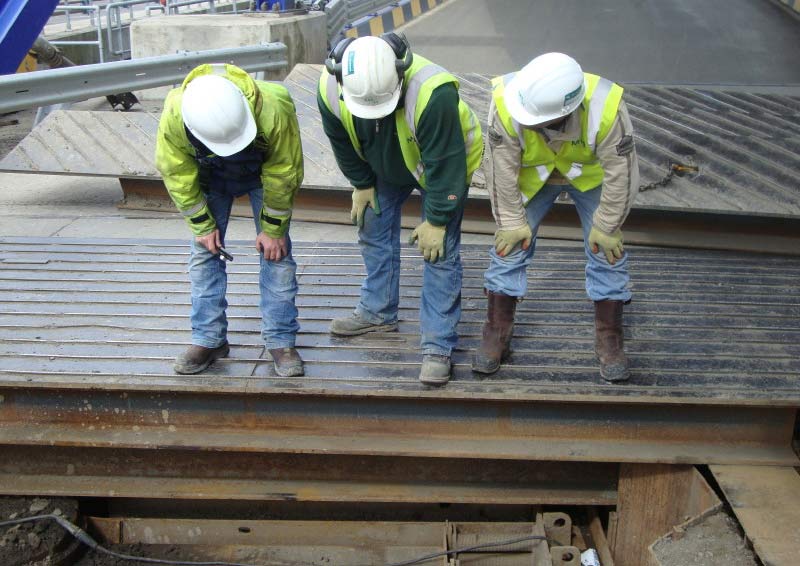Safety in the construction industry
In terms of the built environment, the term ‘safety’ generally refers to the condition of being protected, or safe, from hazards and other undesirable events. As construction is one of the most dangerous industries to work in, the positive control and management of hazards and risks to achieve a sufficiently-high level of safety is very important, and is often a legal requirement.
From a safety perspective, a hazard is a condition with the potential to cause physical impairment or health consequences in people or other types of life.
Safety audits are carried out to assess health and safety processes on construction sites, considering; legislative requirements, industry best practice, and the contractor’s own health and safety management systems.
Construction companies use a wide range of safety practices as part of their safety management programmes, with an increasing emphasis on creating a safety culture throughout the organisation.
The term ‘safety’ can also be used to refer to how safe or protected against harmful events a building or structure is when it is in use. This can be in relation to extreme weather, earthquakes, security, operational failures or hazards, and so on.
For a full list of articles related to safety, see Health and Safety.
See also: Building safety.
[edit] Related articles on Designing Buildings
- Automated external defibrillator AED.
- BREEAM Safety and security.
- Building safety.
- Competent person.
- Construction Client Buddy Scheme.
- Construction Health and Safety Group CHSG.
- Electrical safety.
- Electrical safety in the private rented sector.
- Electrical test equipment for use on low voltage electrical systems GS38.
- Fire.
- Health and safety.
- Health and safety plan.
- Injuries on construction sites.
- ISO 23234 and ISO 21542 security and accessibility standards
- Reporting accidents and injuries on construction sites.
- Risk assessment.
- Safety audit.
- Safety briefing.
- Safety management.
- Security.
- Slip and trip hazards.
- Swarf.
- Warning pipe.
- What is a hazard?
- What is CLOCS?
- Working in confined conditions.
[edit] External references
Featured articles and news
RTPI leader to become new CIOB Chief Executive Officer
Dr Victoria Hills MRTPI, FICE to take over after Caroline Gumble’s departure.
Social and affordable housing, a long term plan for delivery
The “Delivering a Decade of Renewal for Social and Affordable Housing” strategy sets out future path.
A change to adoptive architecture
Effects of global weather warming on architectural detailing, material choice and human interaction.
The proposed publicly owned and backed subsidiary of Homes England, to facilitate new homes.
How big is the problem and what can we do to mitigate the effects?
Overheating guidance and tools for building designers
A number of cool guides to help with the heat.
The UK's Modern Industrial Strategy: A 10 year plan
Previous consultation criticism, current key elements and general support with some persisting reservations.
Building Safety Regulator reforms
New roles, new staff and a new fast track service pave the way for a single construction regulator.
Architectural Technologist CPDs and Communications
CIAT CPD… and how you can do it!
Cooling centres and cool spaces
Managing extreme heat in cities by directing the public to places for heat stress relief and water sources.
Winter gardens: A brief history and warm variations
Extending the season with glass in different forms and terms.
Restoring Great Yarmouth's Winter Gardens
Transforming one of the least sustainable constructions imaginable.
Construction Skills Mission Board launch sector drive
Newly formed government and industry collaboration set strategy for recruiting an additional 100,000 construction workers a year.
New Architects Code comes into effect in September 2025
ARB Architects Code of Conduct and Practice available with ongoing consultation regarding guidance.
Welsh Skills Body (Medr) launches ambitious plan
The new skills body brings together funding and regulation of tertiary education and research for the devolved nation.
Paul Gandy FCIOB announced as next CIOB President
Former Tilbury Douglas CEO takes helm.
UK Infrastructure: A 10 Year Strategy. In brief with reactions
With the National Infrastructure and Service Transformation Authority (NISTA).























